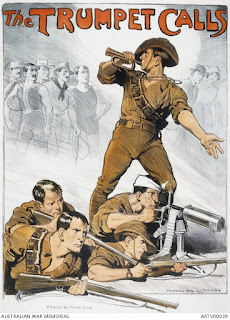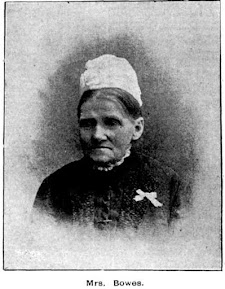Lest We Forget
On ANZAC Day it is fitting to honour the fallen. Today's blog is about a young man who played an integral part in rallying the troops - he was a bugler.
ROBERT FRANCIS CROTHER WILKINSON
Robert was born in 1894 to James Simpson Wilkinson and his wife Helena of Auburn and was one of six children. Robert enlisted on 28 August 1914 under his first name only - just 18 days after Australia entered WW1. He was the first young man under 21 from the Auburn area to enlist. His enlistment papers show him to be a Tinsmith (a maker or repairer of sheet metal). He was 5'4" with light brown eyes and dark hair and he held the position of bugler in the 1st Battalion band.
A bugler had a necessary role to play in the military. The bugle was used to indicate daily routines of camp. Historically the bugle was used in the cavalry to relay instructions from officers to soldiers during Battle. They were also used to assemble the leader and to give marching orders to the camps.
WW1 recruitment poster - AWM archive
The three regular bugle calls were: -
FIRST CALL: - sounded as a warning for soldiers to begin assembling for a formation.
REVEILLE: - signals to soldiers to awake for morning roll call and accompanies the raising of the National Flag.
RECALL: -signals that the present period of physical training or drill is over.
MESS CALL: - signals breakfast, lunch or dinner.
ASSEMBLY: - signals soldiers to assemble at a designated place.
Wilkinson contracted measles and was hospitalised in Cairo and a few weeks later he was diagnosed with acute rheumatoid myocarditis - a heart condition with inflammation of the heart muscle caused no doubt by the attack of measles. He was declared medically unfit and discharged in July 1915.
Robert recovered from his weakness and re-enlisted the following month under his full name, listing his sister as his next of kin. From his Army files it would appear that he had shrunk and changed a little as he was now 5'2.75" with grey eyes! His new unit was the 17th Battalion.
Robert Wilkinson - AWM Archive
As a member of that Battalion, he was part of its first major battle at Pozieres between 25 July and 5 August 1916 and remained in the area of the Somme through a very bleak winter.
Robert was hospitalised from 24 February to 10 March 1917 with PUO - a high fever with no known cause and re-admitted with the same complaint on 22 April to 12 May 1917; he had a further stint in hospital from 23 May to 18 June 1917 with DAH - an alveolar hemorrhage affecting the heart after an infection.
Wilkinson seems to have recovered and participated in the battles of Menin Road in September and Poelcappelle in October in Belgium. He would also have been involved in the German Spring Offensive in 1918.
Robert was killed in action on 09 May 1918 and from the Red Cross files it states that he was part of the Band - the drummer - and they had marched the Battalion up. After dinner whilst sitting under a tree on a biscuit tin he and another young man were killed when a stray shell fell at their feet and exploded. Informants at the time had nothing but praise for the "baby faced" band member. He was 24 years old.
Robert Wilkinson was buried nearby and now lies in the Franvillers Communal Cemetery in France, 19 kms from Amiens. He is in company with over 250 Commonwealth burials from WW1 in a well-kept cemetery. His headstone reads "The Lord is my shepherd I shall not want."
Franvillers Communal Cemetery extension - CWG archive
His younger brother, Alexander James Simpson, enlisted in September 1916 at the age of 18 and on the way to the front contracted Spinal meningitis and spent four months in hospital in Cape Town recovering and returned to Sydney. He was discharged on 9 July 1917. After being given a clean bill of health he, like his older brother, re-enlisted on 15 May 1919 and joined the Special Service Unit in London returning to Australia on 6 September 1919.
Today is one of great reflection and heartfelt thanks for those that gave their all so we could live a free and better life.
LEST WE FORGET
RIP
I have referenced the National Archive files, Red Cross missing and wounded file, and Australian War Memorial information.
If you have any comments, please do so below or add a comment at the group facebook page which can be found from a search for rookwoodcemeterydiscoveries.
or simply send me a message at
lorainepunch@gmail.com
Until next week.






Killed by a stray shell falling at his feet when resting under a tree - I wonder if they watched as it dropped out of the sky? Or did they know nothing about it? Curious to see if your comments section works after your tweaks!
ReplyDeleteYes, I wondered that also. Perhaps it wasn't the only one falling from the sky to watch
Delete